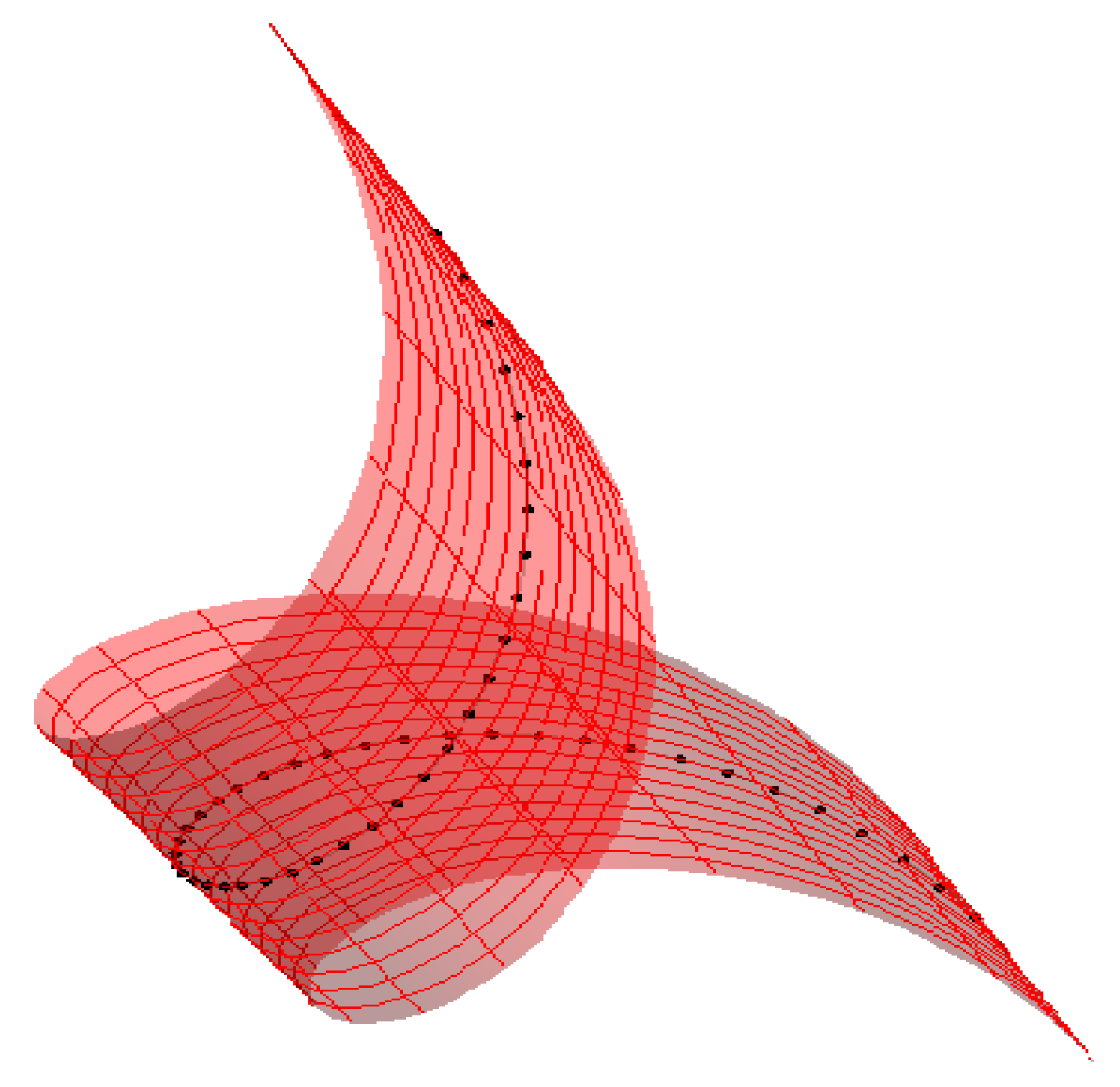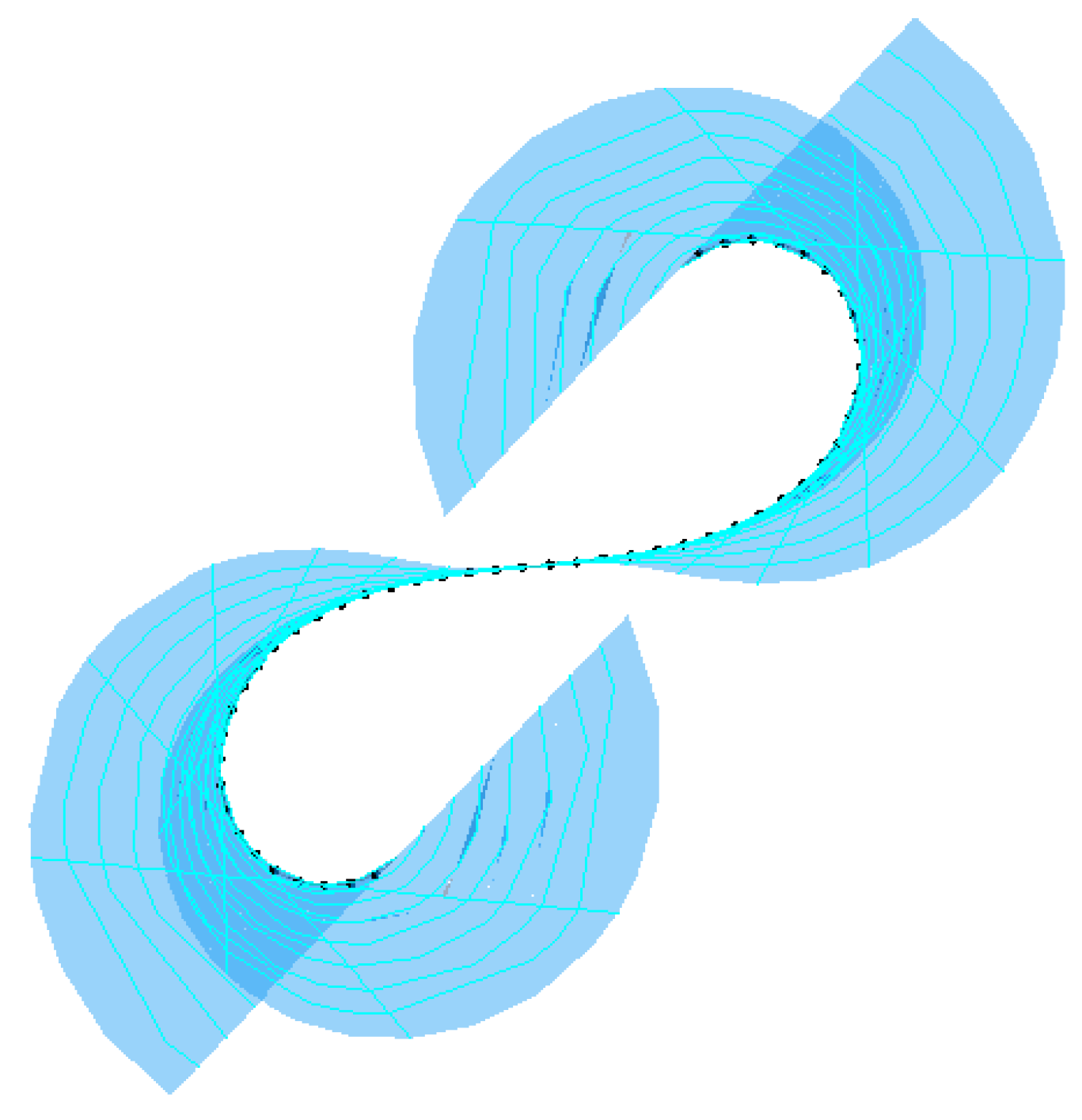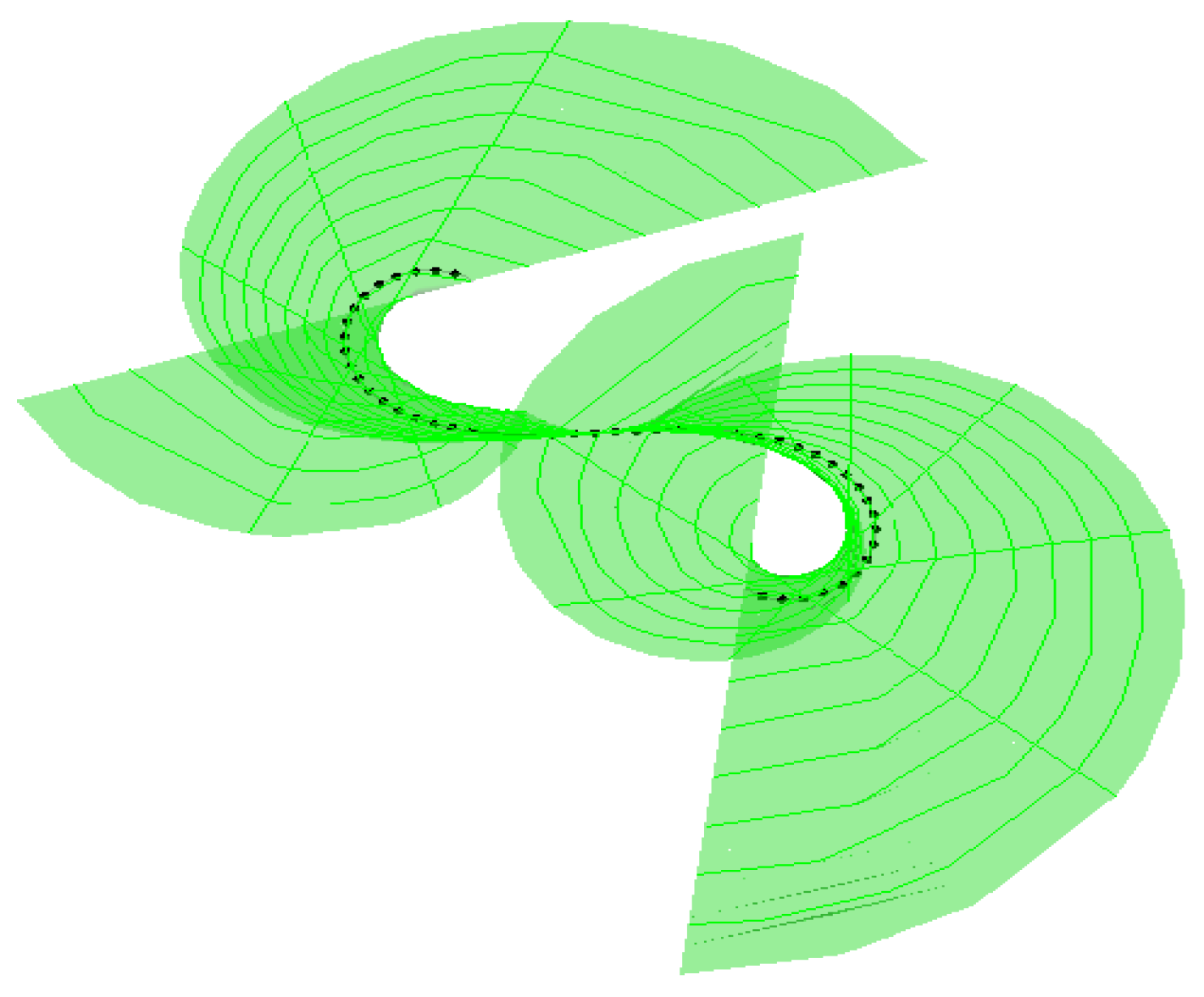Constant Angle Ruled Surfaces with a Pointwise 1-Type Gauss Map
Abstract
1. Introduction
2. Preliminaries
- i.
- If the constant vector C vanishes and f is a regular function, the pointwise 1-type Gauss map of M is called the first kind.
- ii.
- If the constant vector C does not vanish and f is a regular function, the pointwise 1-type Gauss map of M is called the second kind.
- iii.
- If , the pointwise 1-type Gauss map of M is called harmonic [8].
3. Constant Angle Ruled Surface with Pointwise 1-Type Gauss Map
3.1. Constant Angle Ruled Surface Parallel to Tangent Vector
3.2. Constant Angle Ruled Surface Parallel to Principal Normal Vector with Pointwise 1-Type Gauss Map
- i.
- ,
- ii.
- ,
- iii.
- () or ( and ).
- i.
- requires , that is, vanishes.
- ii.
- requires .
- iii.
- Considering (i) and (ii), Equation (3) becomesThese equalities give us or ; therefore, from the fact that implies that .
3.3. Constant Angle Ruled Surface Parallel to Binormal Vector with Pointwise 1-Type Gauss Map
- i.
- ,
- ii.
- provided that ,
- iii.
- provided that .
- i.
- requires , that is, vanishes.Then, we obtain the following coefficient components for u:
- ii.
- If , then by the fact that .
- iii.
- If , then from . In this case, can be zero or non-zero.
4. Conclusions
Author Contributions
Funding
Data Availability Statement
Conflicts of Interest
References
- Chen, B.Y. Total Mean Curvature and Submanifolds of Finite Type; World Scientific Publisher: Singapore, 1984. [Google Scholar]
- Chen, B.Y. Finite Type Submanifolds and Generalizations; University of Rome: Rome, Italy, 1985. [Google Scholar]
- Chen, B.Y.; Ishikawa, S. On classification of some surfaces of revolution of finite type. Tsukuba J. Math. 1993, 17, 287–298. [Google Scholar] [CrossRef]
- Chen, B.Y.; Piccinni, P. Submanifolds with finite type Gauss map. Aust. Math. Soc. 1987, 35, 161–186. [Google Scholar] [CrossRef]
- Baikoussis, C.; Blair, D.E. On the Gauss map of ruled surfaces. Glasg. Math. J. 1992, 34, 355–359. [Google Scholar] [CrossRef]
- Baikoussis, C.; Chen, B.Y.; Verstraelen, L. Ruled surfaces and tubes with finite type Gauss map. Tokyo J. Math. 1993, 16, 341–348. [Google Scholar] [CrossRef]
- Kim, Y.H.; Yoon, D.W. Ruled surfaces with pointwise 1–type Gauss map. J. Geom. Phys. 2000, 34, 191–205. [Google Scholar] [CrossRef]
- Chen, B.Y.; Choi, M.; Kim, Y.H. Surfaces of revolution with pointwise 1-type Gauss map. J. Korean Math. Soc. 2005, 42, 447–455. [Google Scholar] [CrossRef]
- Dursun, U. Flat surfaces in the Euclidean space E3 with pointwise 1-type Gauss map. Bull. Malays. Math. Sci. Soc. 2010, 33, 469–478. [Google Scholar]
- Choi, M.; Kim, Y.; Yoon, D. Classification of ruled surfaces with pointwise 1-type Gauss map in Minkowski 3-space. Taiwan. J. Math. 2011, 15, 1141–1161. [Google Scholar] [CrossRef]
- Soliman, M.A.; Abd-Ellah, H.N.; Hassan, S.A.; Saleh, S.Q. Darboux ruled surfaces with pointwise 1-type Gauss map. Sohang J. Sci. 2017, 2, 1–8. [Google Scholar]
- Li, Y.; Eren, K.; Ayvacı, K.H.; Ersoy, S. The developable surfaces with pointwise 1-type Gauss map of Frenet type framed base curves in Euclidean 3-space. AIMS Math. 2023, 8, 2226–2239. [Google Scholar] [CrossRef]
- Antón-Sancho, Á. Fixed points of automorphisms of the vector bundle moduli space over a compact Riemann surface. Mediterr. J. Math. 2024, 21, 20. [Google Scholar] [CrossRef]
- Zamora Saiz, A.; Zúñiga-Rojas, R.A. Stratifications on the Moduli Space of Higgs Bundles. In Geometric Invariant Theory, Holomorphic Vector Bundles and the Harder-Narasimhan Filtration; Springer Briefs in Mathematics; Springer: Cham, Switzerland, 2021. [Google Scholar]
- Antón-Sancho, Á. Automorphisms of order three of the moduli space of Spin-Higgs bundles. Hokkaido Math. J. 2018, 47, 387–426. [Google Scholar]
- Leticia, B.P.; Lange, H. A stratification of the moduli space of vector bundles on curves. J. Reine Angew. Math. 1998, 494, 173–187. [Google Scholar]
- Biswas, I.; García-Prada, O.; Hurtubise, J. Pseudo-real principal G-bundles over a real curve. J. Lond. Math. Soc. 2016, 93, 47–64. [Google Scholar] [CrossRef]
- Antón-Sancho, Á. Fixed points of principal E6-bundles over a compact algebraic curve. Quaest. Math. 2024, 47, 501–513. [Google Scholar] [CrossRef]
- Munteanu, M.I.; Nistor, A.I. A new approach on constant angle surfaces in E3. Turk. J. Math. 2009, 33, 169–178. [Google Scholar]
- Güler, F.; Saffak, G.; Kasap, E. Timelike constant angle surfaces in Minkowski space . Int. J. Contemp. Math. Sci. 2011, 6, 2189–2200. [Google Scholar]
- Atalay, G.S.; Güler, F.; Kasap, E. Spacelike constant angle surfaces in Minkowski 3-space. J. Math. Comput. Sci. 2012, 2, 451–461. [Google Scholar]
- Lopez, R.; Munteanu, M.I. Constant angle surfaces in Minkowski space. Bull. Belg. Math. Soc. Simon Stevin 2011, 18, 271–289. [Google Scholar] [CrossRef]
- Nistor, A. Certain constant angle surfaces constructed on curves. Int. Electron. J. Geom. 2011, 4, 79–87. [Google Scholar]
- Özkaldı, S.; Yaylı, Y. Constant angle surfaces and curves in E3. Int. Electron. J. Geom. 2011, 4, 70–78. [Google Scholar]
- Li, C.Y.; Zhu, C.G. Construction of the spacelike constant angle surface family in Minkowski 3-space. AIMS Math. 2020, 5, 6341–6354. [Google Scholar] [CrossRef]
- Uzunoğlu, B.; Gök, I.; Yaylı, Y. A new approach on curves of constant precession. Appl. Math. Comput. 2016, 275, 317–323. [Google Scholar] [CrossRef]
- Kaymanlı, G.U.; Ekici, C.; Ünlütürk, Y. Constant angle ruled surfaces due to the Bishop frame in Minkowski 3-space. J. Sci. Arts 2022, 22, 105–114. [Google Scholar] [CrossRef]
- Sokur, B.B.; Dirim, T. Conchoidal surfaces in Euclidean 3-space satisfying Δxi=λixi. Univers. J. Math. Appl. 2023, 6, 114–121. [Google Scholar] [CrossRef]





Disclaimer/Publisher’s Note: The statements, opinions and data contained in all publications are solely those of the individual author(s) and contributor(s) and not of MDPI and/or the editor(s). MDPI and/or the editor(s) disclaim responsibility for any injury to people or property resulting from any ideas, methods, instructions or products referred to in the content. |
© 2024 by the authors. Licensee MDPI, Basel, Switzerland. This article is an open access article distributed under the terms and conditions of the Creative Commons Attribution (CC BY) license (https://creativecommons.org/licenses/by/4.0/).
Share and Cite
Baltić, V.; Eren, K.; Savić, A.; Ersoy, S. Constant Angle Ruled Surfaces with a Pointwise 1-Type Gauss Map. Mathematics 2024, 12, 1861. https://doi.org/10.3390/math12121861
Baltić V, Eren K, Savić A, Ersoy S. Constant Angle Ruled Surfaces with a Pointwise 1-Type Gauss Map. Mathematics. 2024; 12(12):1861. https://doi.org/10.3390/math12121861
Chicago/Turabian StyleBaltić, Vladimir, Kemal Eren, Ana Savić, and Soley Ersoy. 2024. "Constant Angle Ruled Surfaces with a Pointwise 1-Type Gauss Map" Mathematics 12, no. 12: 1861. https://doi.org/10.3390/math12121861
APA StyleBaltić, V., Eren, K., Savić, A., & Ersoy, S. (2024). Constant Angle Ruled Surfaces with a Pointwise 1-Type Gauss Map. Mathematics, 12(12), 1861. https://doi.org/10.3390/math12121861





